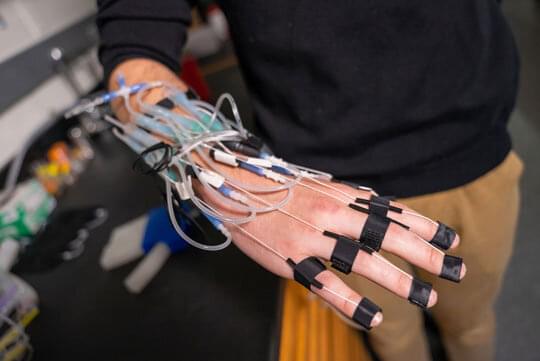About Vladimir Putin
I did not write this song and I do not intend any copyright infringement.
Continue reading “Rush-The Weapon (Part II of Fear) (Lyrics)” »

About Vladimir Putin
I did not write this song and I do not intend any copyright infringement.
Continue reading “Rush-The Weapon (Part II of Fear) (Lyrics)” »
Increased inter-brain synchrony has been linked with social closeness (Kinreich et al., 2017), rapport (Nozawa et al., 2019), agreement (Richard et al., 2021), sense of joint agency (Shiraishi and Shimada, 2021), prosociality (Hu et al., 2017), similarity of flow states (Nozawa et al., 2021), shared meaning-making (Stolk et al., 2014), and cooperation (Cui et al., 2012; Toppi et al., 2016; Szymanski et al., 2017; Cheng et al., 2019). Phase-coupled brain stimulation has led to increased interpersonal synchrony (Novembre et al., 2017), as well as improved interpersonal learning (Pan et al., 2020b). Furthermore, preceding a learning task with synchronized physical activity led to both better rapport and increased inter-brain synchrony, although task performance was unaffected (Nozawa et al., 2019). Nonetheless, learning outcomes (Pan et al., 2020a) and team performance in a variety of tasks (Szymanski et al., 2017; Reinero et al., 2020) can be predicted with the amount of inter-brain synchrony occurring between interacting individuals. Even though collaboration is a dynamic phenomenon, previous studies reporting connections between positive social outcomes and inter-brain synchronization have not explored the temporal aspects of this phenomenon, as recently pointed out by Li et al. (2021). Their fNIRS study revealed differences in the time courses of inter-brain synchronization during two different cooperative tasks. The connection between temporal changes in inter-brain synchronization and the success of collaboration is, however, still not clear.
EEG and fNIRS allow freer movement and more natural interaction compared to magnetic imaging such as fMRI and MEG, arguably lending themselves most easily to actual interactive situations. However, interpersonal synchronization and mirroring between people engaged in social interaction involve quite fast timing precision. For example, participants’ movements were synchronized to less than 40 ms in the mirror game, in which participants improvise motion together (Noy et al., 2011). As EEG measures the electrical activity of the brain, it represents a faster changing signal than hemodynamic measurement, i.e. measures of blood flow, such as fNIRS. This makes EEG a suitable method for investigating fast changes in phase synchronization of oscillatory activity during dynamic social interaction, when taking into account the limitations of the method in regards to signal-to-noise ratio.
In this study, we wanted to investigate whether cooperative action of physically isolated participants would lead to inter-brain phase synchronization. We were especially interested in the temporal dynamics of inter-brain synchrony and its connection to performance in a collaborative task. We attempted to create an experimental setup which would facilitate the occurrence of inter-brain synchrony, while removing any bodily cues and controlling, as much as possible, for spurious synchronization. We also wanted to create a granular performance measure that could be calculated for any segment of the data, to make it possible to investigate dynamic changes in synchrony during the measurement and their connection to dynamic changes in collaborative success during the task.
“The idea was to build a society like we have for all the other disciplines in medicine,” says Evelyne Bischof, a professor of medicine at Shanghai University of Medicine and Health Sciences and the inaugural vice president of the society. She has previously spearheaded educational efforts with Zhavoronkov and others, co-developing a formal course on longevity medicine for doctors. At the ARDD meeting, Bischof announced their course had just received continuing medical education (CME) accreditation from the American Medical Association.
“Longevity medicine is crystallizing as a discipline,” says Andrea Maier, an internal medicine specialist and geriatrician at National University of Singapore who is serving as the society’s inaugural president. One thing that’s not yet clear, several experts told me, is whether longevity will come to be established as a sub-discipline of geriatrics or internal medicine or whether it will become a separate medical specialty unto itself.
“Whichever way it goes,” Maier says, “it’s happening.”
Some mathematicians have sought a logical proof for the existence of God. Here’s what they discovered.

This is perhaps the strangest thing about the arrow of time: “It only lasts for a little while,” says Carroll.
It’s very hard to picture what might happen if the arrow of time eventually vanishes. “When we think we produce heat in our neurons,” says Rovelli. “Thinking is a process in which the neuron needs entropy to work. Our sense of time passing is just what entropy does to our brain.”
Continue reading “Why does time go forwards, not backwards?” »
From the tiniest subatomic scales to the grandest cosmic ones, solving any of these puzzles could unlock our understanding of the Universe.
Electronic computing and communications have advanced significantly since the days of radio telegraphy and vacuum tubes. In fact, consumer devices now contain levels of processing power and memory that would be unimaginable just a few decades ago.
But as computing and information processing microdevices get ever smaller and more powerful, they are running into some fundamental limits imposed by the laws of quantum physics. Because of this, the future of the field may lie in photonics—the light-based parallel to electronics. Photonics is theoretically similar to electronics but substitutes photons for electrons. They have a huge potential advantage in that photonic devices may be capable of processing data much faster than their electronic counterparts, including for quantum computers.

Add analog and air-driven to the list of control system options for soft robots.
In a study published online this week, robotics researchers, engineers and materials scientists from Rice University and Harvard University showed it is possible to make programmable, nonelectronic circuits that control the actions of soft robots by processing information encoded in bursts of compressed air.
Continue reading “Fluidic circuits add analog options for controlling soft robots” »

Engineers at UC Riverside have unveiled an air-powered computer memory that can be used to control soft robots. The innovation overcomes one of the biggest obstacles to advancing soft robotics: the fundamental mismatch between pneumatics and electronics. The work is published in the open-access journal, PLOS One.
Pneumatic soft robots use pressurized air to move soft, rubbery limbs and grippers and are superior to traditional rigid robots for performing delicate tasks. They are also safer for humans to be around. Baymax, the healthcare companion robot in the 2014 animated Disney film, Big Hero 6, is a pneumatic robot for good reason.
Continue reading “Air-powered computer memory helps soft robot control movements” »
Artificial intelligence presents a major challenge to conventional computing architecture. In standard models, memory storage and computing take place in different parts of the machine, and data must move from its area of storage to a CPU or GPU for processing.
The problem with this design is that movement takes time. Too much time. You can have the most powerful processing unit on the market, but its performance will be limited as it idles waiting for data, a problem known as the “memory wall” or “bottleneck.”
When computing outperforms memory transfer, latency is unavoidable. These delays become serious problems when dealing with the enormous amounts of data essential for machine learning and AI applications.
